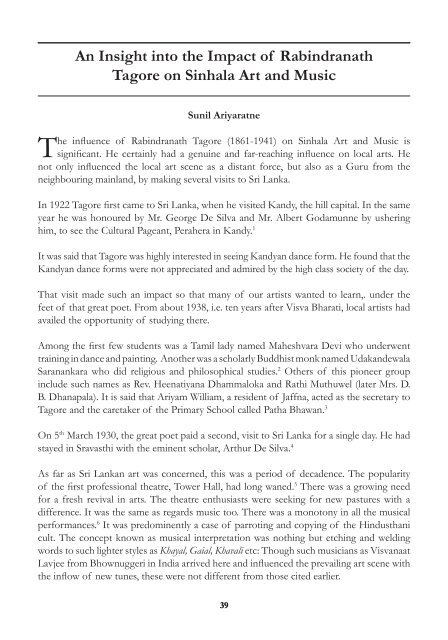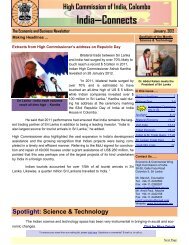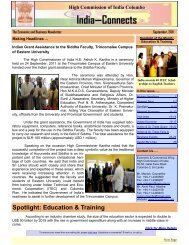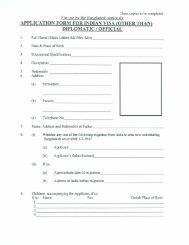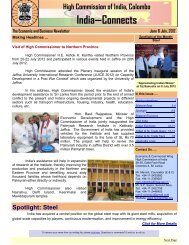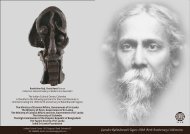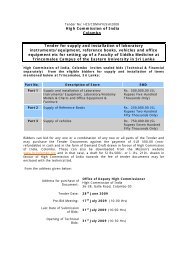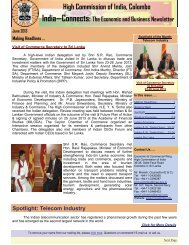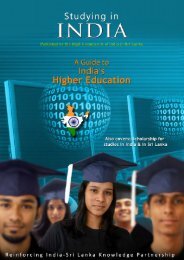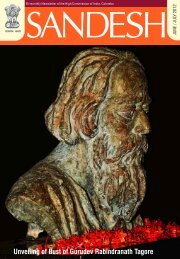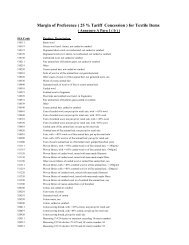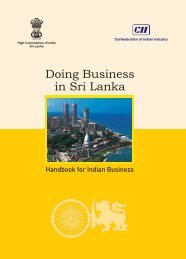Remembering Rabindranath Tagore Volume - High Commission of ...
Remembering Rabindranath Tagore Volume - High Commission of ...
Remembering Rabindranath Tagore Volume - High Commission of ...
Create successful ePaper yourself
Turn your PDF publications into a flip-book with our unique Google optimized e-Paper software.
An Insight into the Impact <strong>of</strong> <strong>Rabindranath</strong><br />
<strong>Tagore</strong> on Sinhala Art and Music<br />
Sunil Ariyaratne<br />
The influence <strong>of</strong> <strong>Rabindranath</strong> <strong>Tagore</strong> (1861-1941) on Sinhala Art and Music is<br />
significant. He certainly had a genuine and far-reaching influence on local arts. He<br />
not only influenced the local art scene as a distant force, but also as a Guru from the<br />
neighbouring mainland, by making several visits to Sri Lanka.<br />
In 1922 <strong>Tagore</strong> first came to Sri Lanka, when he visited Kandy, the hill capital. In the same<br />
year he was honoured by Mr. George De Silva and Mr. Albert Godamunne by ushering<br />
him, to see the Cultural Pageant, Perahera in Kandy. 1<br />
It was said that <strong>Tagore</strong> was highly interested in seeing Kandyan dance form. He found that the<br />
Kandyan dance forms were not appreciated and admired by the high class society <strong>of</strong> the day.<br />
That visit made such an impact so that many <strong>of</strong> our artists wanted to learn,. under the<br />
feet <strong>of</strong> that great poet. From about 1938, i.e. ten years after Visva Bharati, local artists had<br />
availed the opportunity <strong>of</strong> studying there.<br />
Among the first few students was a Tamil lady named Maheshvara Devi who underwent<br />
training in dance and painting. Another was a scholarly Buddhist monk named Udakandewala<br />
Saranankara who did religious and philosophical studies. 2 Others <strong>of</strong> this pioneer group<br />
include such names as Rev. Heenatiyana Dhammaloka and Rathi Muthuwel (later Mrs. D.<br />
B. Dhanapala). It is said that Ariyam William, a resident <strong>of</strong> Jaffna, acted as the secretary to<br />
<strong>Tagore</strong> and the caretaker <strong>of</strong> the Primary School called Patha Bhawan. 3<br />
On 5 th March 1930, the great poet paid a second, visit to Sri Lanka for a single day. He had<br />
stayed in Sravasthi with the eminent scholar, Arthur De Silva. 4<br />
As far as Sri Lankan art was concerned, this was a period <strong>of</strong> decadence. The popularity<br />
<strong>of</strong> the first pr<strong>of</strong>essional theatre, Tower Hall, had long waned. 5 There was a growing need<br />
for a fresh revival in arts. The theatre enthusiasts were seeking for new pastures with a<br />
difference. It was the same as regards music too. There was a monotony in all the musical<br />
performances. 6 It was predominently a case <strong>of</strong> parroting and copying <strong>of</strong> the Hindusthani<br />
cult. The concept known as musical interpretation was nothing but etching and welding<br />
words to such lighter styles as Khayal, Gaial, Khavali etc: Though such musicians as Visvanaat<br />
Lavjee from Bhownuggeri in India arrived here and influenced the prevailing art scene with<br />
the inflow <strong>of</strong> new tunes, these were not different from those cited earlier.<br />
39


